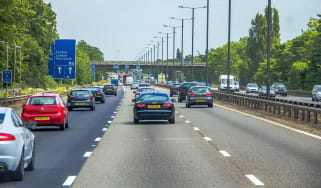Reporting potholes and claiming for damage: complete guide
Potholes are an increasingly prevalent annoyance for UK drivers – here’s everything you need to know

There’s no mistaking the feeling of driving over a pothole. The sudden crash through the suspension is enough to give the car’s occupants a good shake, but it can also cause damage to the tyres, wheels and even the structure of the car itself.
It’s an increasingly common problem for UK motorists, as Government funding for road maintenance hasn’t kept pace with the rate of deterioration – in fact, UK road maintenance spending halved between 2006 and 2019, according to the Organisation for Economic Co-operation and Development (OECD).
As modern cars get larger and heavier, especially the latest EVs with their big battery packs, there’s a risk that roads could degrade even more rapidly. If the number of potholes on our roads increases, so do the chances of hitting one, so what do UK drivers need to know?
Fortunately, drivers can claim compensation from their local authority for damage caused by potholes. Potholes can also be reported to a local authority so that they are aware of the issue – although there’s no promise that it’ll get fixed any time soon. We’ll cover what you need to know about both of these processes in this guide, as well the causes behind potholes.
How do I report a pothole?
The procedure for reporting a pothole varies depending on where you are. Drivers in the UK are advised to visit a government web page dedicated to just this issue. After entering the postcode of the road with the pothole, it will direct you to the relevant local authority website. From here, follow the instructions for reporting the pothole.
If you wish to report a pothole on a major highway in, such as a motorway or A-road, this must be reported to the relevant authority:
- If the road is in England: info@highwaysengland.co.uk or 0300 123 5000
- If the road is in Scotland: info@trafficscotland.org or 0800 028 1414
- If the road is in Wales: contact@traffic-wales.com or 0300 123 1213
- If the road is in Northern Ireland: visit the pothole reporting webpage
What will the local authority do?
Each local authority deals with potholes in a slightly different manner with varying timescales, some more transparently than others.

Usually, reported potholes are inspected and marked with paint if a repair is deemed necessary. Highways Essex employs a colour-coding scheme, with orange or purple paint depending on its severity. The pothole is also given a priority status from one to four. Priority Four potholes are usually only repaired as part of the next programme of planned maintenance. However, a Priority One pothole on a heavily trafficked county route might be made safe within two hours of being reported, with a full repair performed within five working days.
Your local authority website should make it clear how it deals with potholes, and may also present information on road repair funding and maintenance programmes that are in progress or upcoming.
How do I claim pothole damage compensation?
If you’ve fallen victim to pothole damage, there’s a good chance you’ll be able to recoup the repair costs from the local authority. It’s important to photograph any damage caused and hang onto any receipts or invoices from repair work.
The local authority should also provide you with the information necessary to claim compensation for costs arising from pothole damage. You should be able to find the relevant page by entering "compensation" into the search box on the local authority's website.
When you find the page, it should outline the process for claiming compensation. You're usually required to have reported the pothole beforehand – you'll be given an enquiry number after doing so and this will form the basis of your claim.
You also need to be able to prove that the road is one that falls under local authority jurisdiction and that the pothole could be regarded as dangerous. You also need to prove that the road defect was the direct cause of injury or damage and that you have suffered loss in person – this is why the photographs and receipts are important.
You may choose to appoint a representative to pursue a claim on your behalf, although it's normal for local authorities to treat all claims uniformly – the impetus of a solicitor is unlikely to accelerate the outcome of your claim.
What is a pothole?
Without getting bogged down in the fundamentals of road-building, most roads are laid in several layers, starting with compacted aggregate at the very bottom and topped with a smooth, hard-wearing surface dressing, with binder and base levels in between.
The surface is usually either laid in tarmacadam (a mixture of bitumen tar, sand and gravel) or concrete, and should be able to cope with appropriate densities of traffic without showing serious signs of wear and tear for many years if laid correctly.
However, as time passes, tiny imperfections in the material can weather and open up. As water gets into the gaps, it can freeze and expand or dry out as the temperature rises, and the resulting movement can weaken the area immediately surrounding the original defect. As the affected material breaks up, it's gradually displaced by passing traffic, and once much of the loose material has been thrown aside, a pothole is formed.
What damage can a pothole do?
The first part of your car to make contact with a pothole is its tyre, and since it's made from a softer material than other components, it's likely to take the brunt of the force. Fortunately, tyres are pretty tough and good-quality ones are designed with the punishment of road imperfections in mind. They're not indestructible, though, and a heavy impact can damage or even burst a tyre.
Tyres are filled with air and the air displaced in an impact has to go somewhere. This can result in a bulge forming in the tyre sidewall. In extreme cases, a pothole shock can result in a considerable distortion of the tyre's shape, which you'll be able to feel as a vibration as you drive. In this case, the tyre will need replacing.
However, if your tyre picks up a bulge, you've really been lucky. Far worse is for the tyre to blow out, if the sudden rise in air pressure is too much for it to stand. At the very least, this will cause you the inconvenience of struggling with a jack and spare wheel or waiting for recovery.
A car's suspension and steering are next in line to suffer from a pothole impact, with the tracking – the settings that keep the wheels pointing in the right direction – easily thrown out by such a sudden force. Fortunately, tracking is fairly cheap to readjust, but poor wheel alignment can point towards other problems, such as bent suspension components that need repair or replacement.
Recommended

Classic car tax exemption: which historic vehicles qualify?
Most Popular

Suzuki’s new 10-year warranty is free – here’s how to get it
Tips & advice

Car dashboard warning lights: what does each symbol mean?

Electric car charging stations: public networks, charger types, apps and maps









